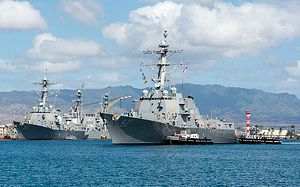At a public event hosted by Sasakawa Peace Foundation-USA on May 6 in Washington D.C., Admiral Scott Swift strongly defended the robustness of the U.S. Pacific Fleet – a force he described as “the most capable, ready, and significant naval force in the world” – and its ability to sustain the Asia “rebalance.”
However, Swift, commander of the U.S. Pacific Fleet, is not complacent, and believes some important changes can be made to further improve the Pacific Fleet’s performance in the Western Pacific.
The Pacific Fleet is comprised of 3rd Fleet, headquartered in San Diego, California, and 7th Feet, headquartered in Yokosuka, Japan. Historically, the 7th Fleet took command of 3rd Fleet ships when they crossed the International Date Line westward, but on April 26, Swift reiterated his longstanding preference to expand the role of the 3rd Fleet commander in the Asia-Pacific region. In other words, he wants Vice Admiral Nora Tyson and her staff to maintain operational control over some of the ships that cross the International Date Line.
The USS Momsen, USS Decatur, and USS Spruance became the first ships to be deployed under this new arrangement on April 27.
Swift had been pushing for such a change since last September. He questioned the need for the, practically speaking, rather arbitrary administrative demarcation. The change would not require a change of headquarters or home ports, but would allow for greater cooperation between the two fleets in “areas with the greatest instability.” Swift is looking for ways to enable Tyson to “more fully employ her fleet forward.”
Swift believes that this change will allow the U.S. Navy to take fuller advantage of 3rd Fleet’s capacity and capability. Swift envisions a future where the two fleets could divide responsibility for tasks in the Asia-Pacific; for example, by having 3rd Fleet deal with the Navy’s response to a tsunami while 7th Fleet deals with earthquake relief.
Swift told reporters: “The future is very unpredictable. If we hit that capacity point, we don’t want to find ourselves for the first time asking the question, well let’s see what we can do with 3rd Fleet. We need to start those actions now.” Preparedness is key, and should there ever be a “tipping point” where the full spectrum of U.S. capabilities must be brought to bear in the Western Pacific, it will be too late unless the groundwork has already been laid for 3rd Fleet’s operations.
During his speech at the security forum, Swift shared his own experience and how it shaped his view of 3rd Fleet’s role: “As a previous 7th Fleet commander, when I took over Pacific Fleet I was surprised that everybody looked at Pacific Fleet through the optics of 7th Fleet, and 3rd Fleet was almost the forgotten fleet. So I’ve spent some time bringing 3rd Fleet back into the focus.”
What does this change mean for the Pacific Fleet’s and its effectiveness? Hopefully, this will allow for U.S. naval commanders – especially those based in the eastern Pacific, who have not yet established such traditional ties – to enhance trust and improve cooperation with their counterparts among allied nations.
Tyson represented Swift at the review of Japanese naval forces last October. She has also met with Australian and New Zealand navy leaders recently, and Swift wants 3rd Fleet to have an active role in the biannual U.S.-Australian Talisman Sabre exercises.

































